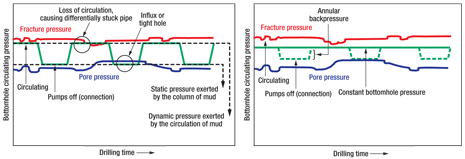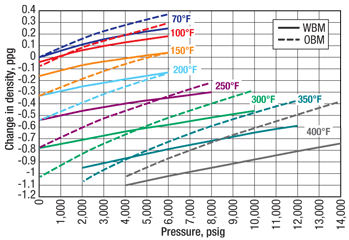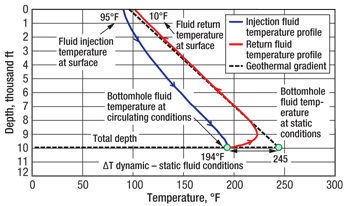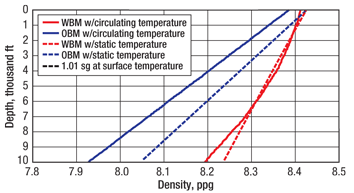Findings suggest that temperature’s effect on annular pressure substantially impacts the ability to precisely estimate the static and dynamic fluid densities.
Maurizio Arnone and Paco Vieira, Weatherford International Ltd.
Managed pressure drilling (MPD) in extremely narrow operating windows is a subtle affair. In these precariously balanced wellbore conditions, even small variations in wellbore temperature influence the drilling fluid’s critical relationship with formation pore pressure and fracture gradient.
Exactly how temperature affects fluid density—and thus annular pressure—is illuminated by recent research that challenges prior assumptions for drilling in hazardous conditions. These insights enhance MPD capabilities for reducing risk and costs, and for drilling previously undrillable wells.
EXTREME DRILLING HAZARDS
The narrow operating window that characterizes many deep wells presents a considerable drilling hazard. In these difficult environments, small pressure fluctuations can result in costly scenarios of lost circulation, gas kicks, differentially stuck pipe or even total loss of well control. When frictional pressure loss (the difference between dynamic and static pressure) exceeds the operating window parameters, the well becomes undrillable using conventional methods. Figure 1 illustrates this process and the associated problems.
These problematic pressure variations are inherent to conventional drilling practices using open-loop circulating systems. Constant bottomhole pressure (CBHP) is an MPD variant that has proven highly successful in these conditions—often drilling wells that were economically or physically impossible using conventional methods.
The key effect of CBHP methodology is maintaining the same bottomhole pressure (BHP) whether the fluid column is static or circulating. When annular flowing pressure is lost, the reduction is countered at the surface by applying annular backpressure to the closed-loop circulating system. This annular pressure control is achieved with a dedicated choke system that prevents the bottomhole pressure fluctuations that normally occur when cycling mud pumps on and off to circulate, make connections and perform other rig operations.
As a result, drillers can more accurately “walk the line” between pore pressure and fracture gradient. Doing so reduces non-productive time spent fighting well problems and cuts fluid costs. Risks to the well, rig and personnel are also minimized. In addition, wells can be drilled deeper and completed at the optimal hole size because casing points can be set deeper.
These unique capabilities are a particular advantage in managing uncertainty in high-pressure, high-temperature, deep wells and in complex geological environments such as unconformities.
As well depth increases, both hydrostatic pressure and temperature increase. These factors have opposing effects on the static and dynamic equivalent density of the drilling fluid. An increase in hydrostatic and dynamic pressure (caused by compression) increases the equivalent fluid density. But density is reduced by increasing temperature and the resulting thermal expansion. These effects are often assumed to effectively cancel each other.
However, research suggests that temperature’s effect on annular pressure is much more important than that of pressure to the precise estimation of static and dynamic fluid densities that is especially important to MPD CBHP operations.
 |
|
Fig. 1. Static and dynamic pressure behavior in a conventional drilling operation (left) and in an MPD CBHP operation (right).
|
|
SURFACE VS. DOWNHOLE DENSITY
Accurate estimation of equivalent circulating density (ECD) and bottomhole static and circulating pressures are essential to CBHP methods. But drilling fluid density measured at the surface does not represent the drilling fluid density throughout the wellbore. As the fluid is circulated in a deepening hole, it is subjected to a range of downhole pressure and temperature. Consequently, the actual drilling fluid density must consider static and dynamic pressures and frictional pressure loss.
By considering all these parameters, wells with extremely narrow 50- to 100-psi windows have been successfully and efficiently drilled. Without these fine-tuned estimations, kick and loss scenarios would have been riskier and more expensive.
Research involved several investigative avenues. Laboratory tests were conducted on drilling fluid density variations with pressure and temperature. Analytical predictions were made regarding circulating temperature and transient effects of circulation on drilling fluid density. Hydraulic simulations were designed to study the effect of temperature and pressure in determining bottomhole circulating and static pressures. The simulations were also used to verify the hydraulic models during the field applications.
There are several concepts important to this research. Equivalent static density (ESD) is an expression of the hydrostatic pressure exerted by a static column of fluid. Hydrostatic pressure is defined as the pressure exerted at any point by a static column of liquid, and is a function of the density of the liquid and the height of the liquid column.
Frequently, hydrostatic pressure is calculated using the fluid density at standard or wellsite conditions. Because the fluid density is affected by the formation pressure and temperature, the calculated hydrostatic pressure must be corrected using the variation in fluid density. This obtains the real value of static bottomhole pressure (SBHP).
ECD is defined as the sum of the drilling fluid ESD and the pressure loss in the annulus due to fluid flow.
Higher formation temperatures cause thermal expansion of the drilling fluid that lowers ESD and ECD, while higher formation pressures result in compression that increases ESD and ECD. The effects of temperature and pressure do not necessarily cancel each other. The final determination of the effect must be made based on specific conditions when the MPD CBHP operation is planned and executed.
DETERMINING FLUID TEMPERATURES
Fluid temperature at a certain depth is not constant due to thermal phenomena when circulating the drilling fluid. Differences between the geothermal and drilling fluid temperatures mean that heat is transferred from the formation to the hole. This process can be analyzed as the heat transfer between the fluid inside the drillstring (moving from surface to bottom) and the fluid inside the annular space (moving from bottom to surface).
A mathematical analytical model is used to predict the circulating drilling fluid temperature in a stationary state as a function of depth inside the drillstring and in the annular space.1 This is done while drilling or circulating the well. The model results, verified by temperature logs, have been used in a variety of situations to successfully predict bottomhole temperature.
However, the deductions and analytical expressions used to determine the drilling fluid temperature profile in the annular space have been performed on vertical wells. For directional wells, the same methodology was applied to a mathematical expression that adjusts to any well trajectory. These expressions are used to describe well deviation in more general terms and to avoid the iterative calculations in the analytical model.
PREDICTION ALGORITHMS
Development and testing of different algorithms to predict the effect of formation pressure and temperature on the fluid density drew from earlier experiments examining the density of oil- and water-based drilling fluids.2
These prior laboratory studies acquired a variety of data during their evaluation of density changes. The evaluations examined 11- to 18-ppg oil- and water-based drilling fluids at temperature and pressure ranges of 70–400°F and 0–14,000 psig. Temperature was controlled and measured within ±5°F, and pressure was controlled within ±100 psi.
The experiments concluded that the density changes for a specific type of drilling fluid can be treated as a function of temperature and pressure. This change is independent of the initial fluid density. Also, it was determined that, for fluids of equal density at surface conditions, the density of an oil-based mud (OBM) will be greater than a water-based mud (WBM) density at high temperature and pressure.
The most important of the conclusions is that the effects of temperature and pressure, as opposites, are not canceled—they have a net effect on the drilling fluid density. In almost all CBHP research cases, fluid density is less when affected by high temperature and pressure (at bottomhole) than at standard conditions of temperature and pressure (at surface, 60°F and 14.73 psi). If a change in fluid density due to temperature and pressure is evident, its effect on static and dynamic bottomhole pressure should be considered when CBHP methods are initiated.
The experimental data is depicted in Fig. 2. In lieu of dedicated software, this experimental data, along with calculated static and circulating fluid temperatures, will result in a good approximation of fluid density change with temperature and pressure. This approximation of fluid density change can then be used to calculate related bottomhole static and circulating pressures.
 |
|
Fig. 2. Experimental data of fluid density changes for water-based and oil-based mud (surface fluid density at surface conditions of 10.69 ppg for WBM and 10.95 ppg for OBM).
|
|
Further experiments determined that temperature effects are more dominant than pressure effects.3 Under low pressures, an increase in temperature may decrease the density of the drilling fluid significantly—which is the expected behavior for slightly compressible fluids.
Previous laboratory data showed that once the temperature is increased from 80°F to 280°F (3.5 times the surface temperature—typical in deep drilling operations), the density of the tested fluid decreased to a range between 0.67 ppg (7.7% less than the original density) and 0.37 ppg (4.3% less than the original density) depending on the pressure conditions (30 psig and 5,000 psig, respectively).3 This data clearly shows the importance of introducing the effects of pressure and temperature on density for pressure loss, hydrostatic pressure and cutting transport calculations.
The experiments also illustrated the effect of density on pressure loss calculation in turbulent flow. Typically, bottomhole turbulent flow is initiated due to reduced hole clearance around the drill collars and sufficiently high flowrates. In addition to fluid rheology, turbulent frictional pressure losses are related to the density of the drilling fluid. As a result, precise determination of density reduction caused by formation pressure and temperature is important when controlling drilling problems. An inaccurate estimation may result in well control problems.
TRANSIENT DENSITY WHILE DRILLING
The effective mud density, which is directly affected by variations in downhole pressure and temperature, is a very important part of MPD CBHP planning and execution. Drilling fluid density is strongly affected by formation temperature. This is true even if temperature can be considered constant at certain depths due to formation consistency. During drilling operations, the drilling fluid will be variously static or circulating. Fluid temperature at that depth will vary following a transient state strongly sensitive to the flowrate.4
Because of fluid circulation, the bottomhole pressure is greater than the hydrostatic pressure of the drilling fluid. This is due primarily to frictional pressure loss in the annular space, but compressibility could also be a dominant effect (more than temperature) when drilling deep wells.
The estimated effect of the temperature in dynamic conditions is very important. The final ECD can be less than the surface drilling fluid density if the temperature effect is dominant over pressure. This is the normal behavior in shallow to medium-depth wells.
The ECD can also be greater than the surface drilling fluid density if the pressure effect is dominant over the fluid temperature, which is common in deep and ultra-deep wells.
When the well is not being circulated, the frictional pressure loss effect is canceled. As a result, the variation in fluid density is strongly affected by the thermal expansion as the fluid temperature increases to reach the geothermal temperature.
When the fluid is circulated, the temperature decreases due to the cooling effect. This change in temperature as a time function (from fluid static to circulating and vice versa) affects the resulting static and dynamic bottomhole pressures. Commercial software and transient hydraulic equations3 were used to determine the fluid temperature profile and the difference between static and circulated temperatures. Figure 3 shows the results obtained using the researcher’s analytical equation to determine the fluid temperature profile and the differences in fluid temperatures when the well is circulated and static.
 |
|
Fig. 3. Fluid temperature profile in a 10,000-ft well with a geothermal gradient of 1.6ºF/100 ft. It is important to note the static and circulating temperature at bottomhole conditions.
|
|
In Fig. 4, ESD and ECD are calculated using the static and circulating fluid temperatures obtained with the analytical equation and commercial hydraulic software. It is important to note the difference between the surface density and the equivalent density at bottomhole conditions. The use of correct values of ESD and ECD is very important for planning and executing an MPD CBHP operation.
 |
|
Fig. 4. Variation in ESD and ECD considering the static and circulating fluid temperatures obtained for a 10,000-ft well.
|
|
A field example shows the potential error that can be caused by compressibility and the transient temperature effect.4 With a surface density of 2.04 specific gravity (sg), the effective density at geothermal conditions (drilling fluid static) was 1.98 sg. When circulation was initiated, the effective density increased to 1.99 sg, and it continued to increase to 2.06 sg after 12 hours of circulation.
The same example also demonstrates the effect of variations in flowrates. The equivalent density changed more rapidly with higher circulation rates and tended to stabilize at a higher value. In most cases, the equivalent density stabilized within 12 hours of drilling fluid circulation.
RESEARCH RESULTS
Research has demonstrated the influence of pressure and formation temperature on the density of drilling fluids and the related effects on ESD and ECD. The tests subjected a diverse group of drilling fluid formulations to a range of common wellbore temperatures and pressures. Real bottomhole pressure data and temperatures in static and dynamic conditions were obtained through downhole logs and evaluations using modern hydraulic software.
This research demonstrates that higher formation temperature causes thermal expansion of the drilling fluid, and in consequence, lower ESD and ECD. Higher formation pressures result in compression and increased ESD and ECD. The two opposites do not necessarily cancel each other; accuracy requires a determination at the time the CBHP application is executed. Failure to consider the effects of pressure and temperature on mud density may result in an inaccurate estimation of bottomhole pressures, and in incorrect application of CBHP methods.
During the initial phase of an MPD CBHP application, it is useful to correlate the theoretical calculations by performing an MPD step-up/step-down trial. This fingerprinting registers the pressure data with the use of a pressure-while-drilling (PWD) tool. The trial also provides an opportunity to train rig personnel. The use of validated hydraulic software that considers the effects of pressure and temperature on the drilling fluid properties over time is extremely important in this process.
The degree to which temperature and pressure will affect the correct application of CBHP depends on the magnitude of the temperature and pressure, the circulating time, the type of drilling fluid and all the factors that have relation to the hydraulic behavior of drilling fluids. But there is definitely a change in density, and it is more evident in high-temperature/high-pressure environments.
In quantitative form based on research data, the density of an oil-based mud at 300°F and 10,000 psi will be 0.3 ppg less than the surface density, for a 1.9% reduction. For a water-based mud at the same pressure and temperature, density is reduced 0.5 ppg, or 4.5%. At a depth of 15,000 ft, the reduction in density caused by temperature and pressure will represent an equivalent of 234 psi for oil-based mud and 390 psi for a water-based mud. Those values could be critical to maintaining constant bottomhole pressure in very narrow operating windows.
ACKNOWLEDGMENT
This article was prepared from SPE/IADC 119882 presented at the SPE/IADC Drilling Conference and Exhibition held in Amsterdam, March 17–19, 2009.
LITERATURE CITED
1 Holmes, C. S. and S. C. Swift, Journal of Petroleum Technology, 22, No. 6, 1970, pp. 670–674.
2 McCordie, W. C., Bland, R. G. and J. M. Hauser, “Effect of temperature and pressure on the density of drilling fluids,” SPE 11114 presented at the 57th Annual Fall Conference and Exhibition of the Society of Petroleum Engineers of AIME, New Orleans, Sept. 26–29, 1982.
3 Demirdal, B., Miska, S. and N. Takach, “Drilling fluids rheological and volumetric characterization under downhole conditions,” SPE 108111 presented at the SPE Latin American and Caribbean Petroleum Engineering Conference, Buenos Aires, Argentina, April 15–18, 2007.
4 Karstad, E. and B. Aadnoy, “Density behavior of drilling fluids during high pressure high temperature drilling operations,” IADC/SPE 47806 presented at the IADC/SPE Asia Pacific Drilling Technology Conference held in Jakarta, Indonesia, Sept. 7–9, 1998.
|
THE AUTHORS
|
 |
Maurizio Arnone is Region Technical Manager for Weatherford’s MPD unit in the Middle East and North Africa. He joined Weatherford in 2006 as a Senior Engineer in the Middle East and North Africa region. Mr. Arnone holds BSc (honors) and MSc degrees in mechanical engineering from the University of the Andes, Venezuela, and the Central University of Venezuela, respectively.
|
|
| |
Paco Vieira is Engineering Manager for Weatherford’s Controlled Pressure Drilling and Testing Services unit for the Middle East/North Africa region (since 2006). Mr. Vieira holds a BSc degree in mechanical engineering from the Metropolitan University in Caracas, Venezuela, and an MSc degree in petroleum engineering from the University of Tulsa, Oklahoma.
|
|







